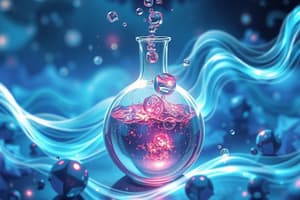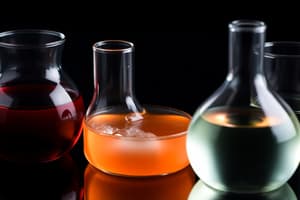Podcast
Questions and Answers
What is the substance that is being dissolved in a solution called?
What is the substance that is being dissolved in a solution called?
- Mixture
- Solution
- Solvent
- Solute (correct)
A solution is a heterogeneous mixture.
A solution is a heterogeneous mixture.
False (B)
What are the two main factors that affect the solubility of a substance?
What are the two main factors that affect the solubility of a substance?
Temperature and pressure
In a saltwater solution, the ______ is the solvent and the ______ is the solute.
In a saltwater solution, the ______ is the solvent and the ______ is the solute.
Match the following solutions with their respective solutes and solvents:
Match the following solutions with their respective solutes and solvents:
Which of the following statements is TRUE regarding the relationship between concentration and solubility?
Which of the following statements is TRUE regarding the relationship between concentration and solubility?
Increasing the pressure generally increases the solubility of gases in liquids.
Increasing the pressure generally increases the solubility of gases in liquids.
Explain how the size of solute particles affects the dissolving process.
Explain how the size of solute particles affects the dissolving process.
What is the primary difference between a saturated solution and an unsaturated solution?
What is the primary difference between a saturated solution and an unsaturated solution?
Sugar dissolves faster in water if it is in the form of a cube rather than a powder.
Sugar dissolves faster in water if it is in the form of a cube rather than a powder.
What happens when a supersaturated solution cools down?
What happens when a supersaturated solution cools down?
The process of separating a soluble solid from a liquid solution by heating the liquid to its boiling point is called ______.
The process of separating a soluble solid from a liquid solution by heating the liquid to its boiling point is called ______.
Match the separation method with its best description:
Match the separation method with its best description:
Which of these is NOT a common application of paper chromatography?
Which of these is NOT a common application of paper chromatography?
Fractional distillation is used to separate components of crude oil based on their boiling points.
Fractional distillation is used to separate components of crude oil based on their boiling points.
What is the primary purpose of a condenser in distillation?
What is the primary purpose of a condenser in distillation?
A ______ solution can dissolve more solute at a given temperature.
A ______ solution can dissolve more solute at a given temperature.
Why does a powdered sugar dissolve faster in water than a sugar cube?
Why does a powdered sugar dissolve faster in water than a sugar cube?
Distillation is a process used to make bottled water from saltwater by removing salt from the water.
Distillation is a process used to make bottled water from saltwater by removing salt from the water.
Explain how rock candy is made.
Explain how rock candy is made.
In the context of solutions, the substance that gets dissolved is called the ______.
In the context of solutions, the substance that gets dissolved is called the ______.
Which method is best suited for separating a mixture of iron filings and sand?
Which method is best suited for separating a mixture of iron filings and sand?
A concentrated solution always has a higher concentration of solute than a diluted solution.
A concentrated solution always has a higher concentration of solute than a diluted solution.
What is the main difference between simple distillation and fractional distillation?
What is the main difference between simple distillation and fractional distillation?
Flashcards
Solution
Solution
A homogeneous mixture of two or more pure substances that appears uniform.
Solute
Solute
The substance that is dissolved in a solution; the smaller part of the mixture.
Solvent
Solvent
The substance that dissolves the solute; the larger part of the solution.
Concentration
Concentration
Signup and view all the flashcards
Temperature (affecting solubility)
Temperature (affecting solubility)
Signup and view all the flashcards
Pressure (affecting solubility)
Pressure (affecting solubility)
Signup and view all the flashcards
Size of solute particles
Size of solute particles
Signup and view all the flashcards
Dilution
Dilution
Signup and view all the flashcards
Concentrated Solution
Concentrated Solution
Signup and view all the flashcards
Diluted Solution
Diluted Solution
Signup and view all the flashcards
Unsaturated Solution
Unsaturated Solution
Signup and view all the flashcards
Saturated Solution
Saturated Solution
Signup and view all the flashcards
Supersaturated Solution
Supersaturated Solution
Signup and view all the flashcards
Evaporation
Evaporation
Signup and view all the flashcards
Filtration
Filtration
Signup and view all the flashcards
Distillation
Distillation
Signup and view all the flashcards
Paper Chromatography
Paper Chromatography
Signup and view all the flashcards
Magnetism
Magnetism
Signup and view all the flashcards
Fractional Distillation
Fractional Distillation
Signup and view all the flashcards
Rock Candy Production
Rock Candy Production
Signup and view all the flashcards
Study Notes
Solutions and Separating Mixtures
- Solution: A homogeneous mixture appearing as a single substance, but composed of two or more pure substances.
- Solute: The substance dissolved; the smaller part of the solution.
- Solvent: The substance doing the dissolving; the larger part of the solution.
- Examples:
- Saltwater: Salt (solute), water (solvent)
- Hot chocolate: Hot chocolate powder (solute), water/milk (solvent)
- Vinegar: Acetic acid (solute), water (solvent)
- Ink: Pigment/dyes (solute), water (solvent)
- Brass: Zinc (solute), copper (solvent)
Factors Affecting Solubility
- Concentration: The amount of solute compared to solvent. Higher concentration means less solubility due to a limit to how much solute can dissolve in a solvent.
- Diluting a solution decreases concentration by adding more solvent.
- Temperature: Higher temperatures increase solubility of both solids and gases in liquids. Hotter solvents have faster-moving particles, leading to more collisions, causing solutes to break down faster and allowing more space in the solvent for solute particles.
- Heating up a solvent lets more solid substances dissolve and less gas will dissolve.
- Pressure: Pressure significantly affects the solubility of gases in liquids. High pressure allows more gas to dissolve (e.g., carbon dioxide in soda).
- Size of Solute Particles: Smaller solute particles dissolve faster because the solvent can interact with a larger surface area. A powdered solute dissolves quicker than a solid chunk of solute.
Types of Solutions
- Unsaturated: A solution that can still dissolve more solute.
- Saturated: A solution that cannot dissolve any more solute.
- Supersaturated: A solution holding more solute than is normally possible at a given temperature. Excess solute will precipitate out as the solution cools.
Making Rock Candy
- Rock candy production involves creating a supersaturated sugar solution, then allowing sugar crystals to grow on a stick.
Separating Mixtures
- Paper Chromatography: Separates substances in a mixture based on their different attractions to a solvent. The substances move at different speeds, separating them on the paper.
- Filtration: Separates insoluble solids from a liquid. A filter prevents solids from passing through.
- Evaporation: Separates a solute from a solvent by evaporating the liquid. The solute remains.
- Magnetism: Separates magnetic materials from non-magnetic materials. Used to separate iron from sand.
- Distillation: Separates a solvent from a solute by boiling the solution and collecting the evaporated solvent as it condenses.
- Used to purify water (removing salts).
- Fractional Distillation: Used to separate components of a mixture, like crude oil, by boiling and collecting vapors at different temperatures.
Studying That Suits You
Use AI to generate personalized quizzes and flashcards to suit your learning preferences.




